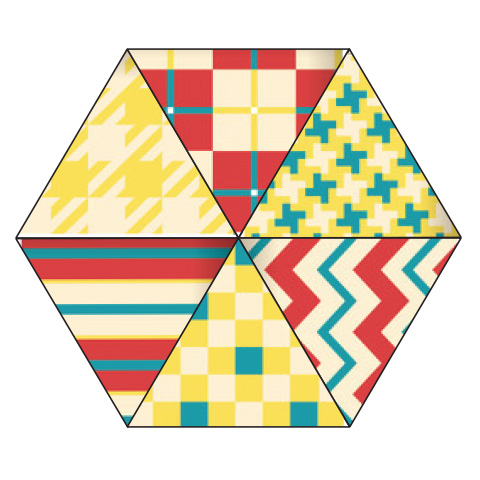Take a step back to a time when life was simpler, quilts were made with one template, and the colors came from the quilter’s creativity or the contents of her scrap box.
Block #1: The Equilateral Triangle
The equilateral (all sides the same) triangle was a popular shape in quilts dating from the 1700s and beyond, including Hour Glass designs from the 1700s that can be found in museums today. The book, America’s Quilts and Coverlets, by Carleton L. Safford and Robert Bishop includes triangle designs from the 1800s, like this:

In 1897, Ladies Art Company of St. Louis, Missouri, offered this pattern, Patchwork Sofa Quilt, for 10 cents.

Click HERE for the Equilateral Triangle template pattern in three sizes and a page of triangles for experimenting with colored pencils or crayons. Stitching by hand or English paper piecing is suggested. The adventurous might try machine piecing some of the shapes in the AQS Vintage One-Patch Series, but the seams will be more difficult to maneuver as the shapes evolve.
To make the templates:
• Trace the templates onto heavy cardboard or plastic.
• Cut along the line so the template matches the measurement. Verify with a ruler.
The templates have NO seam allowance added. This allows the sewing line to be transferred to the wrong side of the fabric as the template is traced around.
To use the templates:
• On the wrong side of the fabric, lay a template, leaving at least a ¼” around each of the edges.
• Trace the template with a marking pencil or pen. Chalk can also be used, but it is important the drawn line remain for use later. Disappearing ink is NOT recommended.
• Continue tracing the template on the wrong side of the fabric leaving room for the seam allowance between pieces until the desired number of pieces are traced.
• Cut around the drawn pieces leaving the ¼” seam allowance. Because the drawn lines are the sewing lines, it is not critical that all seam allowances be completely accurate.
• Store marked pieces in a plastic bag or a box for safekeeping.
A few guidelines for hand piecing:
• Pin two pieces together marking the beginning and end of the seams lines with pins.
• Using a sharp or milliner needle and waxed hand piecing-weight thread, thread the needle and knot the end of the thread in a quilter’s knot.
• Hold the two pieces at each end creating an even tension on the fabric.
• Sew along the drawn line with a locked running stitch. Take four or five bites of fabric with your needle, no farther than 1/8″ apart, loading it up for a running stitch and pull the thread through. As you place your needle back in the fabric for the next stitch, begin before the last stitch of the previous running stitch. This includes the last stitch in the next and locks the stitch.
• When pulling the stitches secure, do not pull too much nor leave the stitches too loose. It is important to pay attention to maintaining even tension.
• Stop when you reach the end of the line where it connects to the next corner. Take a tiny backstitch, a single stitch that goes back over the sewing line, and pass the needle through the loop made taking the stitch. Repeat to secure the knot.
• When sewing units or rows together, take a lock stitch on one side where the seams meet, then pass the needle through the seam allowance and take a lock stitch on the other side of the juncture.
To English Paper Piece:
Are you interested in English paper piecing the shapes? Here’s a guide to English paper piecing. Cut templates from file folders or any bendable but sturdy paper.